The Kenya June 25, 2024 Internet Disruption: Subsea Cable Cut or Shutdown?
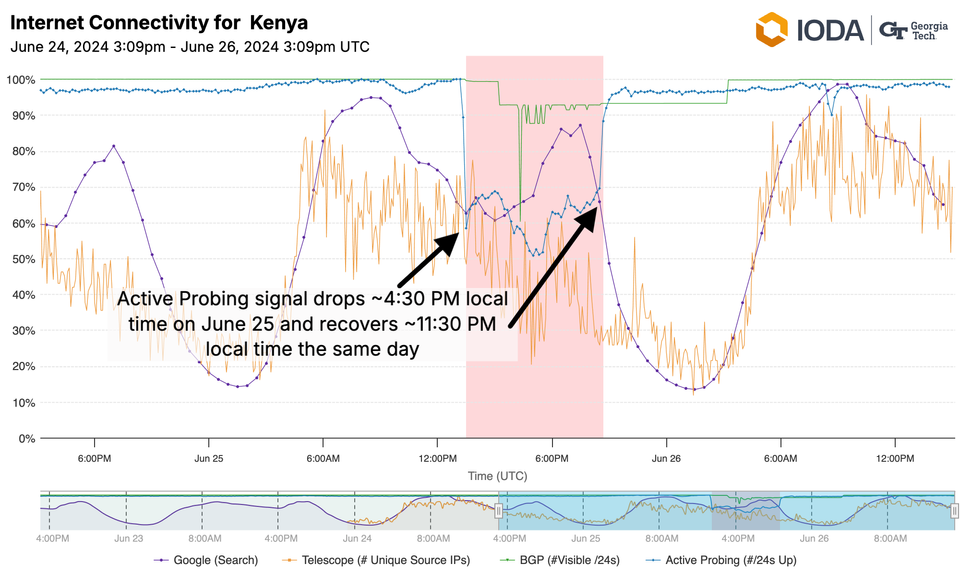
In this analysis, we investigate the temporal nature of the June 25, 2024 Internet disruption in Kenya by comparing it to two previous subsea cable outages in 2024 and comparing it to our findings from the first longitudinal analysis of shutdowns and spontaneous outages.
The IODA team was prompted to investigate and produce this report by the Bloggers Association of Kenya (BAKE) as part of their effort to litigate the Internet disruption and blocking of Telegram in a landmark Kenyan public interest case.
Kenya's Political Context Leading up to the June 25th, 2024 Internet Disruption
In the afternoon of June 25, 2024, Kenya experienced a severe Internet disruption. This disruption occurred seven days into a protest over the Kenya Finance Bill. The bill was widely condemned for imposing new and higher taxes on essential goods and services, such as bread, fuel, mobile money transfers, and digital products, which critics argued disproportionately impacted low-income households, vulnerable people and small businesses. The bill sparked unprecedented, largely youth-led protests, with demonstrators organizing under hashtags like #RejectFinanceBill2024 and #OccupyParliament, reflecting deep frustration with the government’s approach to taxation and economic management. Protesters expressed anger with the government by ignoring public input and prioritizing debt repayment over citizens' welfare. On June 25, the peaceful protests culminated in a deadly clash between police and protesters, when protesters stormed the parliament. Twenty-two people were killed. Kenyan President Ruto bowed to the pressure of protesters and dropped the bill on June 27, 2024. Due to pressure from civil society, the Communications Authority in Kenya issued a press release on June 24, stating they had no intention of shutting down the Internet. This report further examines this declared intention by looking at IODA's measurements and comparing the June 25th disruption to previous outages due to subsea cable damage and to IODA’s groundbreaking research comparing spontaneous outages to shutdowns.
June 25th Internet Disruption
According to IODA data, a disruption to Internet connectivity began ~4:30 PM local time on June 25th, 2024 (see Image 1 below). Looking at IODA’s Active Probing and Routing Announcement signals, we see a clear, abnormal drop in Internet connectivity signals in Kenya. At its lowest levels, 50% of previously responsive network addresses in Kenya stopped responding to IODA’s Active Probing signals and were no longer connected to the global Internet. Routing Announcements (BGP) which is normally stable signal measuring at 100%, also abnormally dropped. . Most networks began to recover at 8:30 PM local time. At the same time, IODA picked up outages in Uganda, Burundi, Rwanda, and Tanzania. The multi-country nature of the event’s impact on Internet connectivity is indicative of disruptions to critical Internet infrastructure connecting several countries like a terrestrial cable, subsea cable, or a cable landing station.
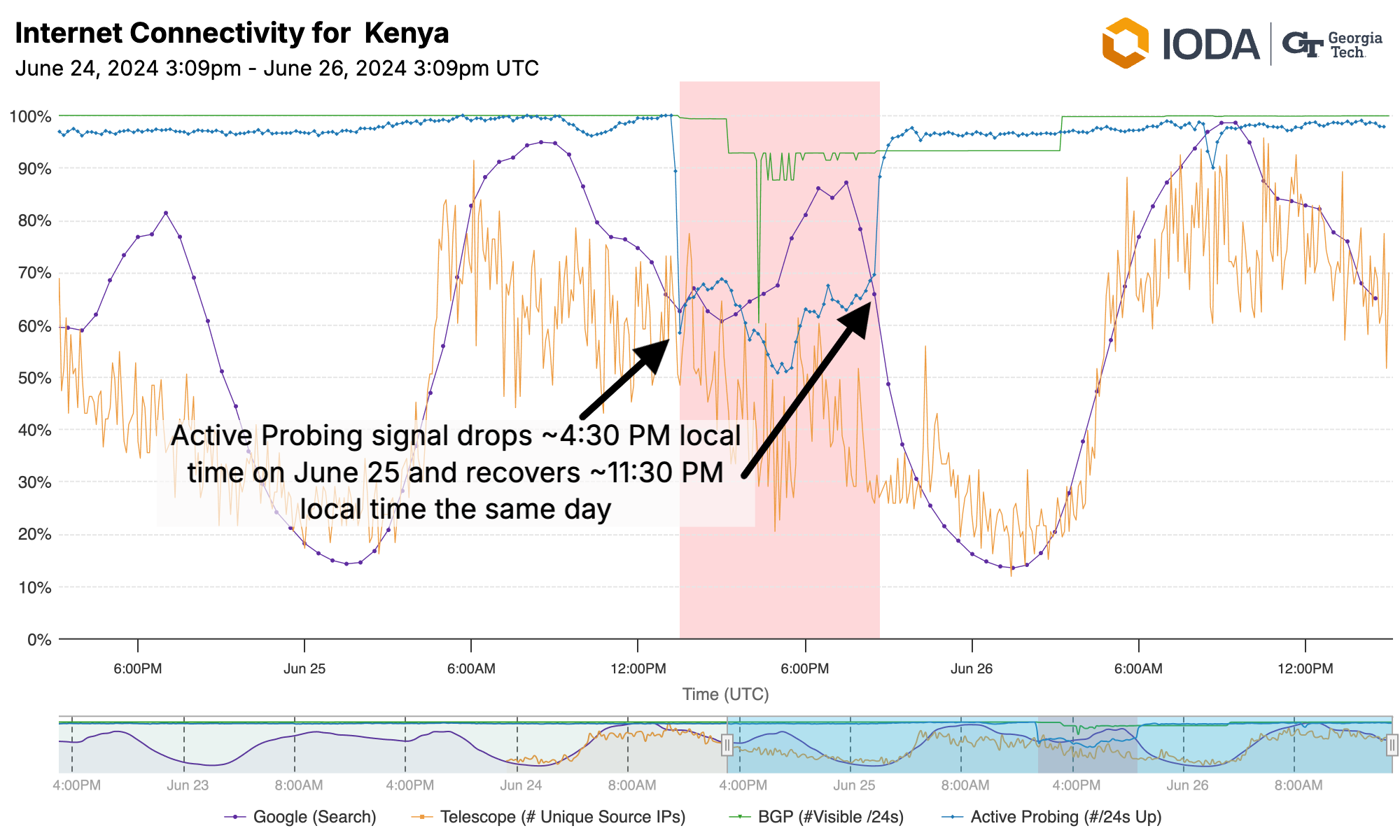
Image 1. This IODA time series data provides a view of Kenya’s Internet disruption on June 25, 2024 from IODA
When investigating Internet disruptions, it is routine to look for announcements made by Internet Service Providers (ISPs). As measurement groups further investigated the disruption on June 25, 2024, two announcements were found by Airtel and Safaricom informing their customers that the disruption was due to an undersea cable outage.
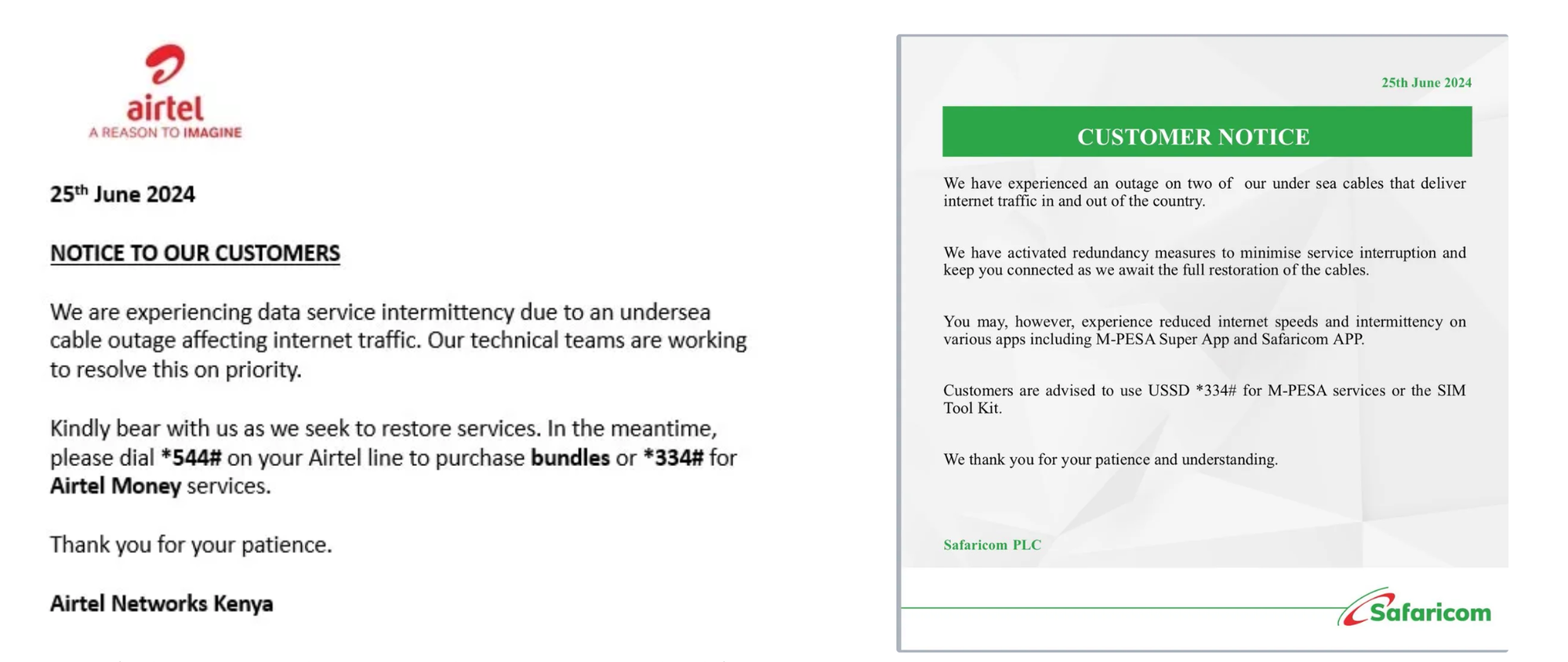
These announcements spurred further investigation into which subsea cables were impacted. Notably, no definitive announcement was made by providers or the Kenyan government on which cables were impacted. One report on LinkedIn by the Co-Founder and Director of a company that provides fiber optic cable transmission service in Kenya mentioned two subsea cables, “PEACE” and “DARE”.
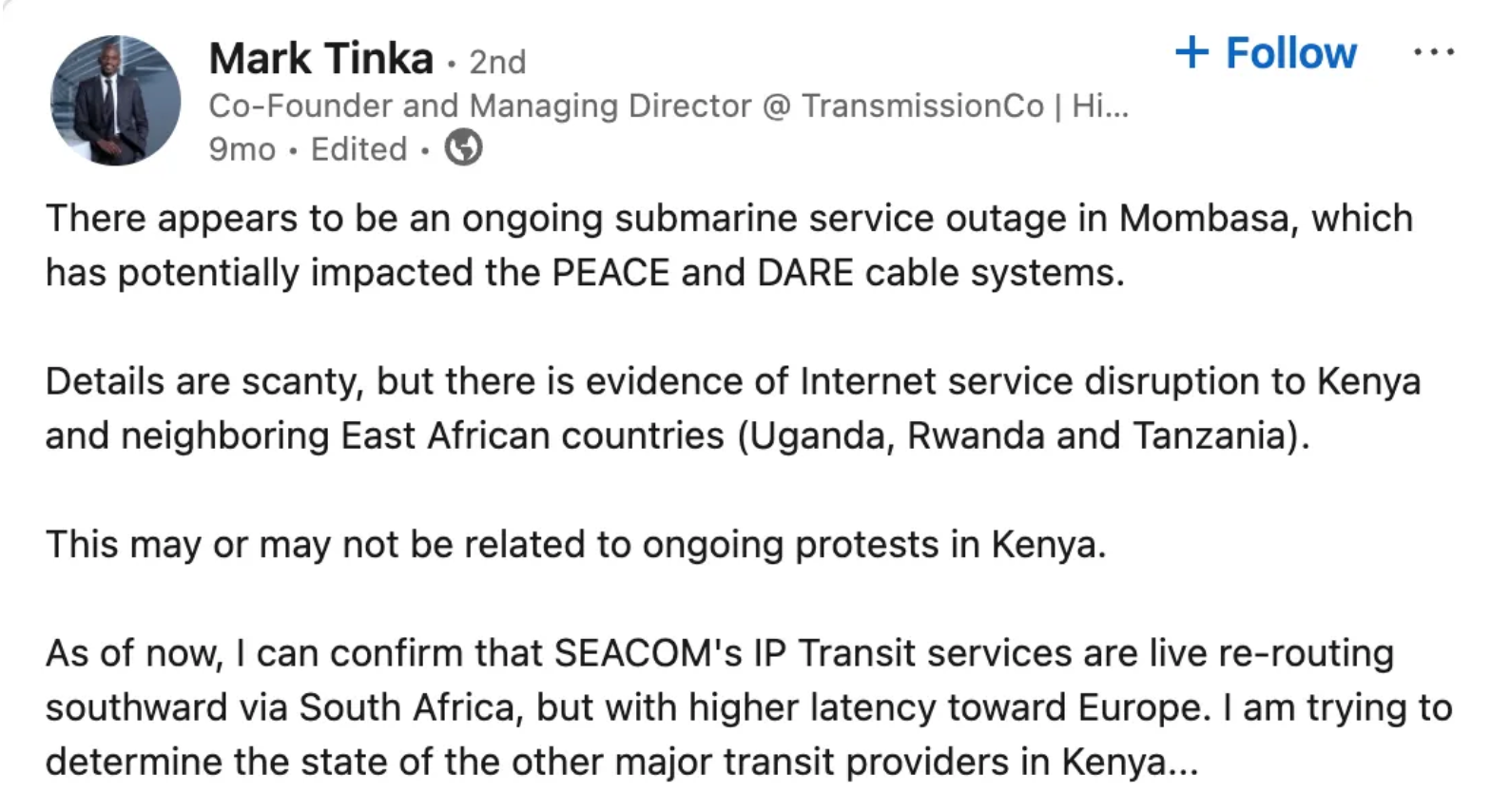
The PEACE and DARE-1 cables both have landing stations in Kenya. These cables do not land in Tanzania, Uganda, Rwanda and Burundi but spillover effects from Kenya could conceivably cause a disruption in Internet connectivity in these neighboring countries due to the cross-boarder links between Kenya and Tanzania and cross-boarder links between Tanzania and Uganda, Rwanda, and Burundi. Having a retrospective view of the June 25th disruption allows us to compare the outage severity and duration to previous subsea cable outages. In the next section we compare this disruption to a subsea cable outage in May of 2024. Notably, the May 2024 subsea cable outage had a less severe impact on Kenya's connectivity signals but lasted longer. Additionally, the ISPs and Kenyan government's communications following the subsea cable outage were, more frequent, much more descriptive of what cables were affected, and included actions being taken to reduce the impact on connectivity. The following section outlines the May 2024 subsea cable outage.
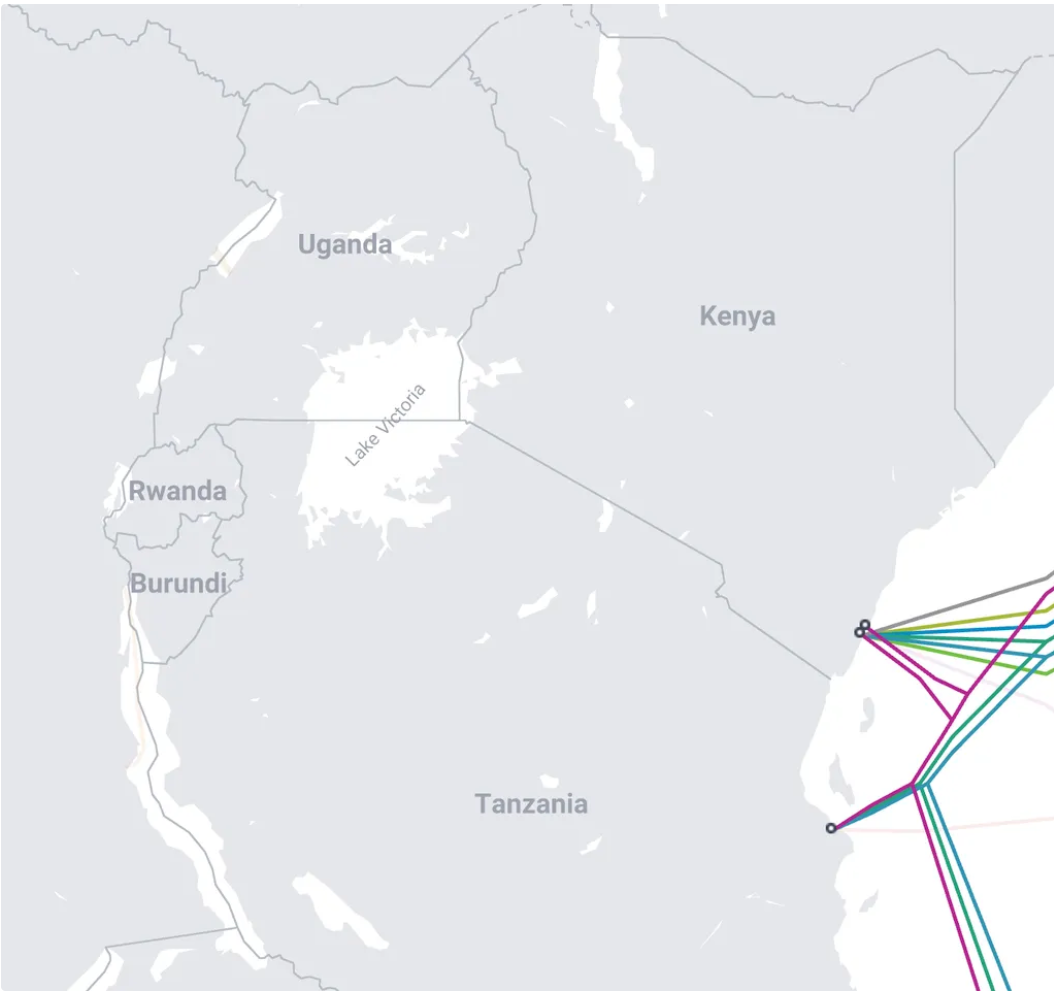
The June 2024 Disruption Response compared to May 2024 Subsea Cable Outage Response
Kenya is connected to 8 subsea cables and has experienced subsea cable cuts before. On May 12th 2024, Kenya experienced an Internet disruption due to a legitimated subsea cable outage. In this section we compare the impact to connectivity, as seen in the IODA dashboard, and the response to the outage by the Communications Authority in Kenya (CA of Kenya) and the Internet Service Providers, Airtel and Safaricom.
On May 12th, 2024 Kenya experienced an Internet disruption due to a subsea cable outage. IODA data shows that this disruption lasted longer but had a less severe impact on Internet connectivity in Kenya, compared to the June 25th disruption.
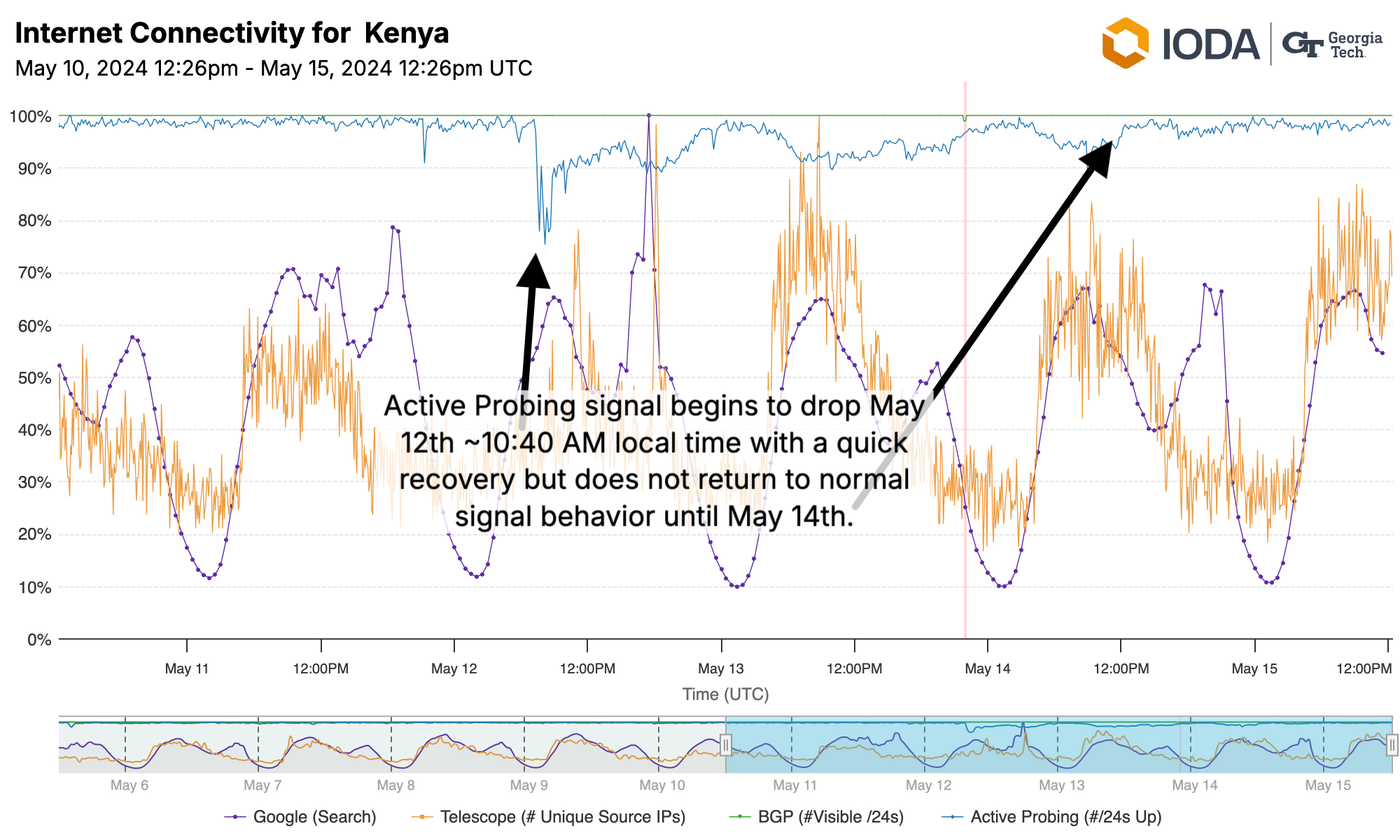
According to IODA data, the Active Probing signal dropped at most 20% on May 12th compared to previous levels and recovered quickly but did not return to normal levels until two days later. In a blog post reviewing the May 2024 subsea cable outage, Cloudlfare Radar noted, “In Kenya, the impact may have been nominal due to steps taken by providers like Safaricom and Airtel Kenya.” Additionally, we note that BGP and Telescope did not show an abnormal drop during this time, only Active Probing.
On May 13th, the CA of Kenya issued a press release made after the subsea cable outage. This press release includes details of the outage by noting which cables and stations were affected as well as the proactive steps being put in place to reroute Internet traffic. After searching the website press release section and their social media, we did not find any subsequent press release from the CA of Kenya that acknowledged any subsea cable outage on June 25, 2024. Additionally, both Safaricom and Airtel issued initial and subsequent social media posts updating how they had implemented measures to restore Internet connectivity in May. No such updates were made in June.
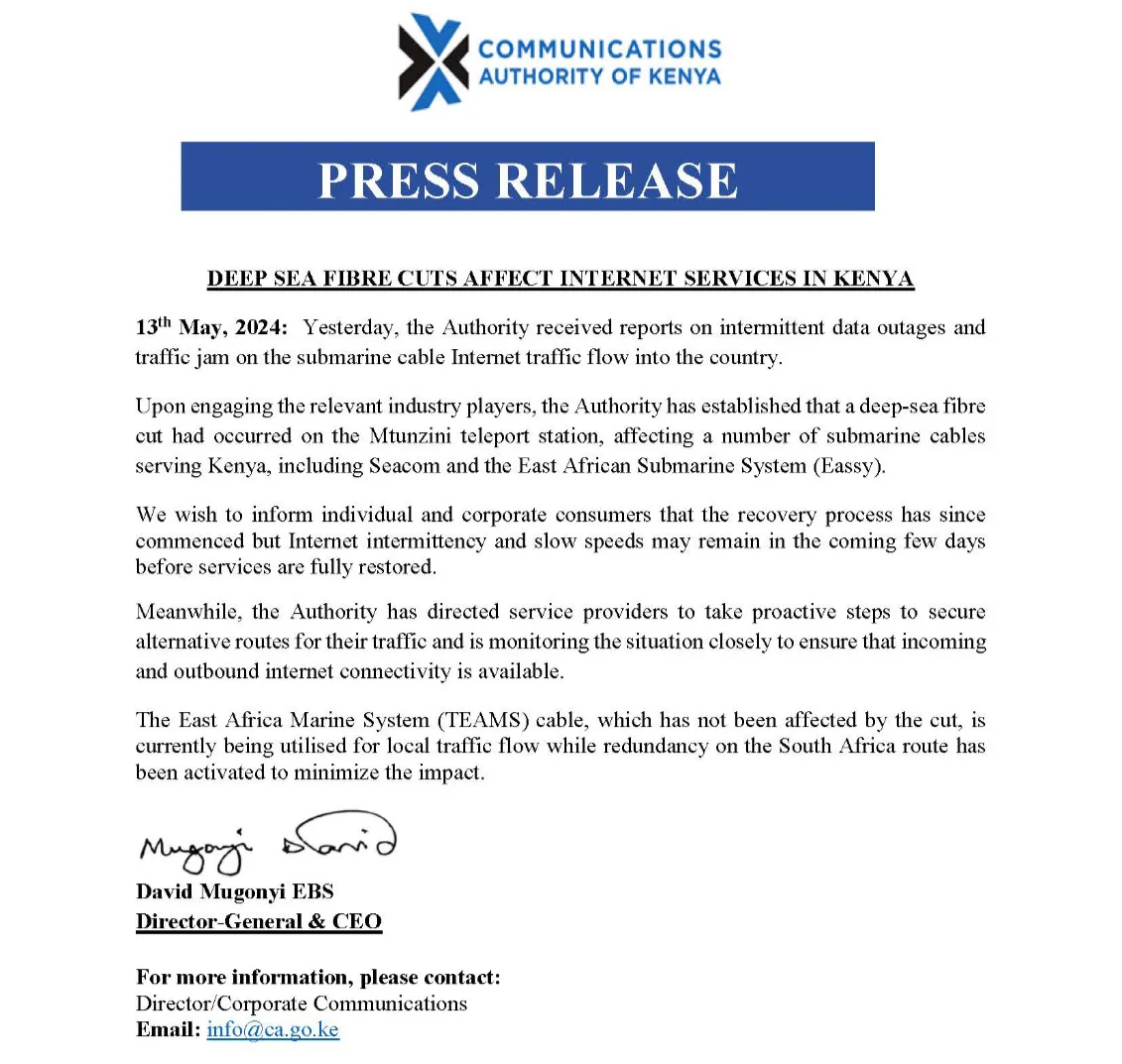

ISPs often have important information during outages and shutdowns as they are either closest to the actions taken to improve service delivery during an outage or they are the ones implementing a government-directed shutdown. Internet measurement sources like IODA or Cloudlfare make use of these announcements to help us interpret cause and context when looking at our Internet measurement data. It is notable how different Safaricom and Airtel’s communications are in May compared to June. In May, they published several subsequent updates assuring customers that measures had been taken to improve service delivery. No such update was made for June 25th. Even more odd was the lack of a press release from the CA of Kenya, especially when compared to the detailed press release on May 13th.
Comparison to March 2024 Subsea Cable Outage Length of Repair Time
In the previous section, we compared the June 25, 2024, Internet disruption to the May 2024 subsea cable outage that affected Kenya. In this section, we compare the June 25, 2024 outage to the March 2024 West Africa subsea cable damage that affected 13 countries with the most heavily affected being Cote d’Ivoire, Benin, and Cameroon. This comparison will further demonstrate the length of repair time for a subsea cable outage.
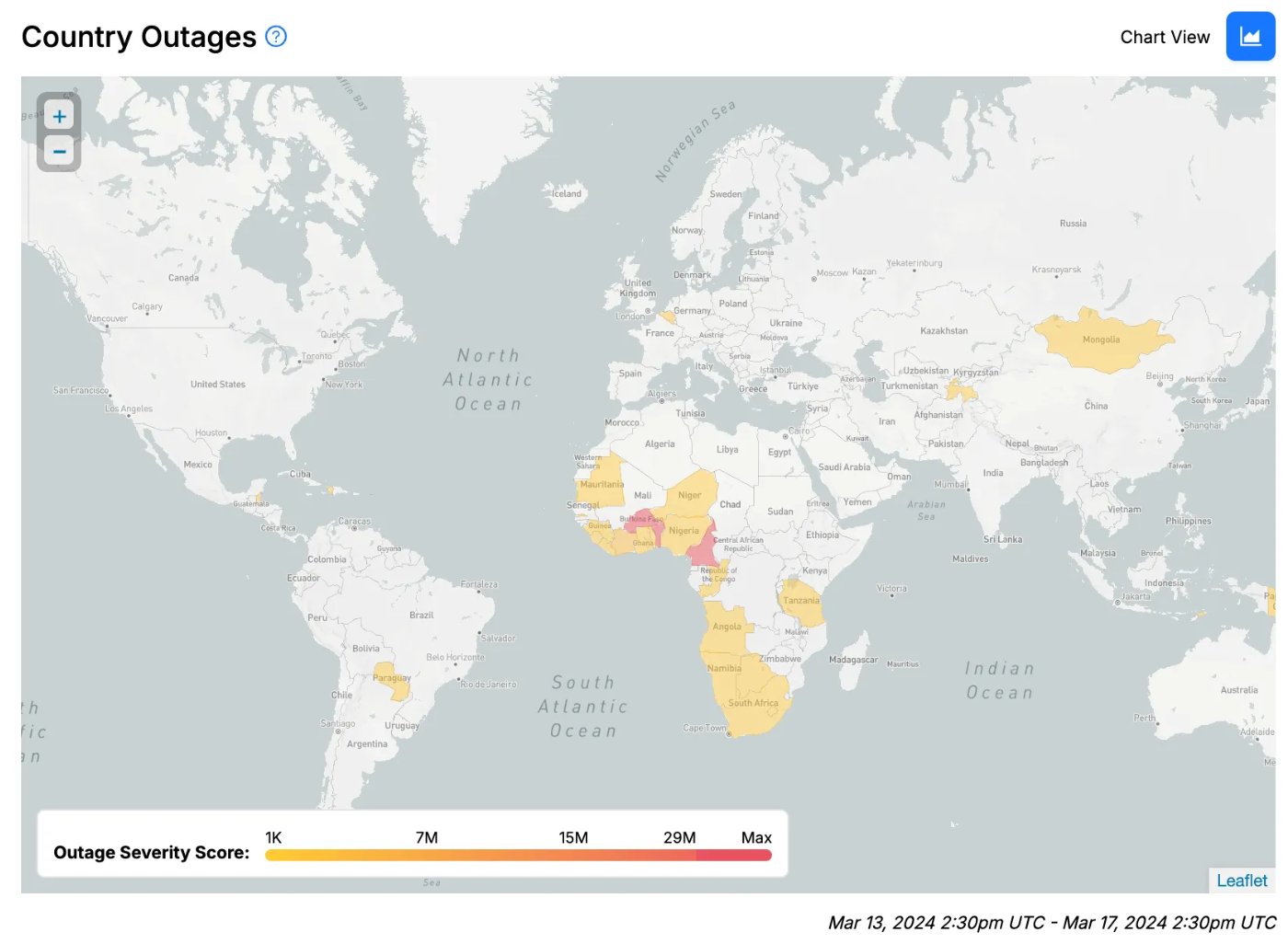
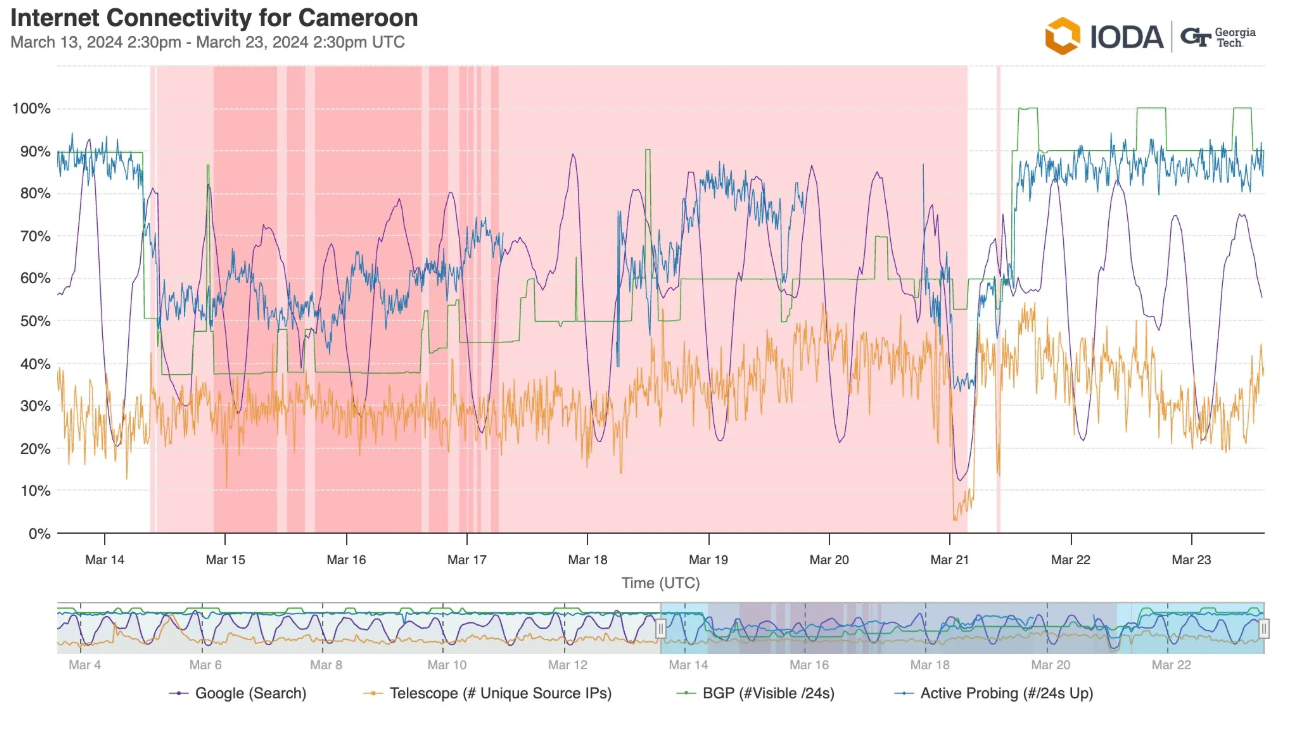
This comparison demonstrates that repairs to subsea cable outages take weeks to implement, as there are limited number of repair vessels globally that may not be in the vicinity to make a repair. Additionally, our research shows that impact of a subsea cable outage on both connectivity and latency will last days. This was seen when the ACE, SAT-3, WACS, MainOne subsea cables were damaged due to a suspected underwater rock slide. As mentioned, this damage greatly impacted Internet connectivity in Cote d’Ivoire, Benin, and Cameroon. In particular for Cameroon, the Internet disruption related to this subsea cable outage lasted 7 days, from March 14 - 21, 2024 (see Image 10 above). Internet connectivity recovery for Cote d’Ivoire took over three days.
If we look at TeleGeography’s reporting on number of days to repair an August 2023 subsea cable cut, we see the following repair durations: ACE - 37 days, SAT-3/WASC - 43 days, WACS - 30 days. Again, this demonstrates that subsea cable outages can require significant repair time. Accordingly, it is not likely that officials notified crews, an available crew navigated to the repair location, and then completed the repair within the ~7 hours of the June 25, 2024 disruption in Kenya.
Temporal Signatures of Shutdowns versus Spontaneous Outages
Additionally, we would like to provide an analysis of the time signatures of spontaneous outages (not government-directed, e.g. a subsea cable outage) versus shutdowns (government-directed), based on our longitudinal study comparing shutdowns and spontaneous outages, Destination Unreachable: Characterizing Internet Outages and Shutdowns. While the article explores various potential correlates with shutdowns and spontaneous outages, here we focus on the temporal signatures.
First, this Internet disruption co-occurred with a protest. In our analysis, we found that shutdowns are 9 times more likely to co-occur with protests than spontaneous outages.
Second, shutdowns (87.4%) are more likely to start on the hour or half hour compared to spontaneous outages (39.6%). Internet measurement data provided the following start times: 4:25 PM by Kentik, 4:30 PM by Coudlfare Radar, and 4:30 PM by IODA. The start time, according to Cloudflare Radar and IODA, aligns more with a shutdown than a spontaneous outage.
Our research also found that shutdowns are more likely to last longer than spontaneous outages. Specifically, the median length of shutdowns is 5.5 hours and the median length of spontaneous outages is 2 hours. Internet measurement data shows the June 25 Kenya Internet disruption lasted ~7 hours, which is closer to the duration of a shutdown, per our historical analysis.
We also found that 55% of shutdowns compared to 15% of spontaneous outages last for multiples of 30 minutes (e.g. 1 hour, 1.5 hours, 2 hours, etc). Kentik reported a duration of 7 hours and 20 minutes. Cloudflare Radar reported 7 hours and 15 minutes. IODA reported ~7 hours. Accordingly, based on these estimated durations, this aligns more with a spontaneous outage.
In our analysis we also found that 67.7% of shutdowns reoccur over the next 1,2,3,4 days; however, we do not find this was the case in Kenya.
Finally, we looked at the number of IODA signals that drop during a shutdown versus a spontaneous outage. 94.5% of shutdowns show visible drops in all three of IODA’s signals, while only 55.3% of spontaneous outages show visible drops in all three of IODA’s signals. For the Internet disruption on June 25, 2024, we found that the loss in connectivity was most visible in Active Probing and BGP. IODA’s Telescope signal in Kenya is too low to reliably detect an abnormal drop.
When looking at co-occurrence with a protest, start time, and length, the Internet disruption in Kenya shows signatures of a shutdown. When looking at duration lasting multiples of 30 and reoccurrence, this Internet disruptions aligns more with a spontaneous outage.
Table 1. Temporal signatures of spontaneous outages versus shutdowns
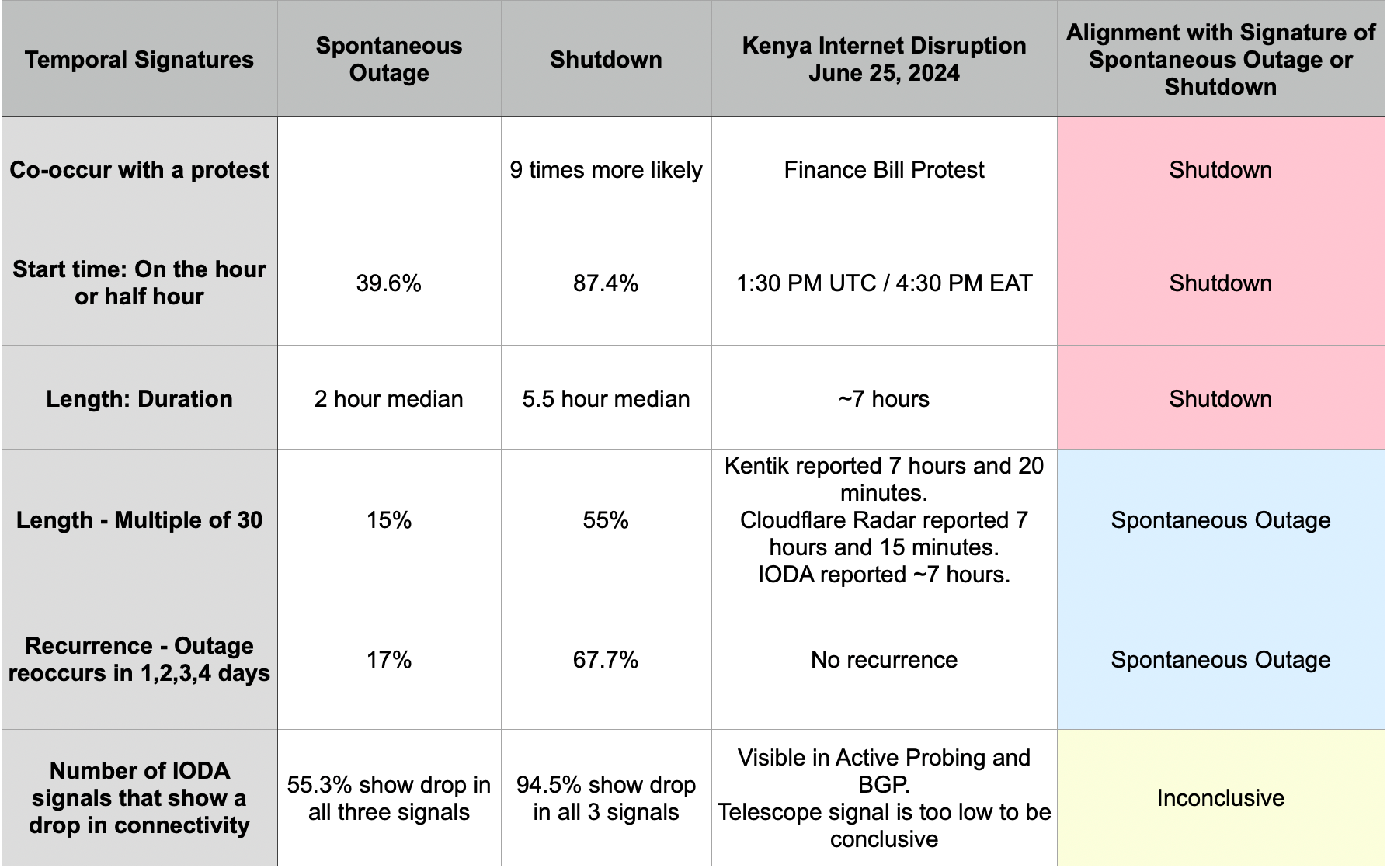
Findings of the Study
IODA data indicates a ~7 hour disruption of the Internet in Kenya that had spillover effects in Uganda, Burundi, Rwanda, and Tanzania. The multi-country nature of the event’s impact on Internet connectivity is indicative of disruptions to critical Internet infrastructure connecting several countries like a terrestrial cable, subsea cable, or a cable landing station.
Internet Service Providers and the Communications Authority of Kenya provided very little information on which cables were impacted and what actions were being taken in response to the June 24, 2025 Internet disruption in Kenya in comparison to the subsea cable outage affecting Kenya on May 12th-14th Internet disruption. The difference in how the outage and response was communicated is stark and notable and raises questions as to whether there was really a subsea cable outage on June 24, 2025 affecting Kenya.
Based on repair times reported for previous legitimated subsea cable outages, such as the ones that affected the African continent on May 12-14th and March 14-21st, it is unlikely that cable repair crews were notified, an available crew embarked and navigated to the repair location, and then completed the repair within the span of the ~7 hours of the June 25, 2024 disruption in Kenya.
Comparing the temporal signatures of the June 24, 2025 Kenya Internet disruption to our longitudinal study comparing spontaneous outages to government-directed shutdowns, we find that the Internet disruption in Kenya shows 3 signatures of a government-directed shutdown, 2 signatures of a spontaneous outage, and 1 signature that was inconclusive.
Please reach out to the IODA team if you have any questions, concerns or comments at ioda-info@cc.gatech.edu.
